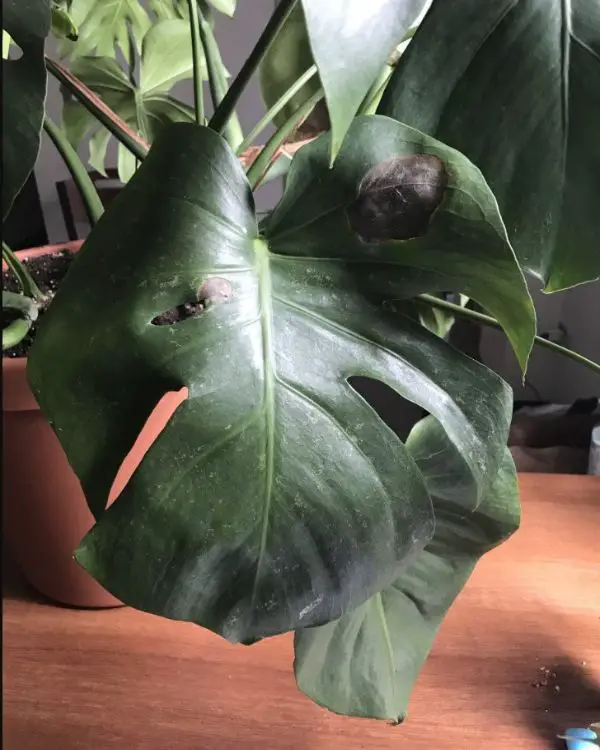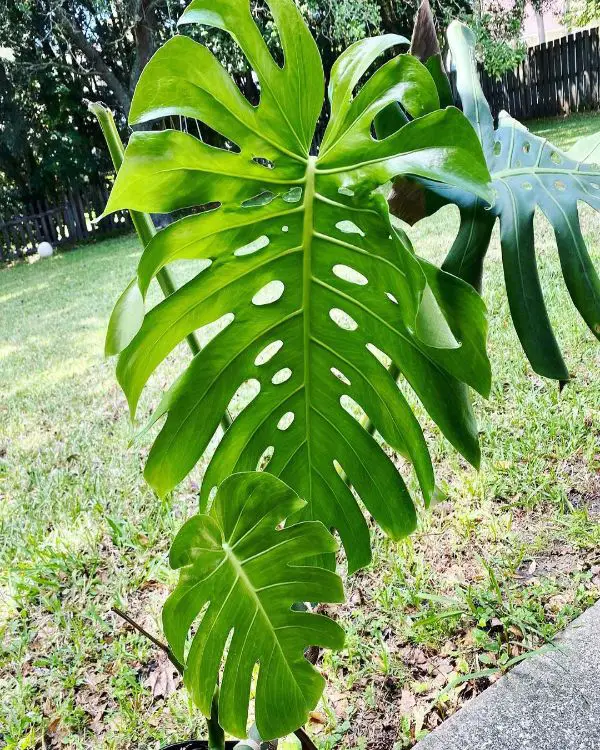Growing Monstera outdoors is quite popular, but what conditions need to be ensured for Monstera to grow well outdoors? If Monstera survives outdoors and what problems should you pay attention to?
Can Monstera Deliciosa live outside?
The answer is yes. It’s a surprise. But you can ultimately grow Monstera outdoors, but there are a few things to keep in mind.
Outdoor plants are delicate and heat-tolerant plants. Monstera Deliciosa is a moisture-loving plant living in semi-shady environments. Since the Monstera tree can grow very tall, it will take up a lot of space if you have a small room in your home. So many people want to move to Monstera to grow outdoors.
Firstly, you should make a roof to grow Monstera. Because Monstera will burn leaves if planted with indirect light. Therefore, it is necessary to make a roof to ensure that the tree still receives light but is not too strong, causing the tree to burn its leaves. You should place Monstera in a well-drained, round shade or light-speckled location. Second, it is recommended to water daily and fertilize monthly.
Since Monstera Deliciosa is moisture-loving, growing it outside can cause moisture to evaporate quickly. So water the plant regularly to maintain moisture. Or you should add coir to increase moisture for your Monstera. Third, you should plant Monstera outside when it’s summer and when it’s cold, move them indoors. Cold weather can hinder the growth of Monstera.
The difference between growing monsteras indoors vs outdoors
Choosing a location to plant Monstera outdoors
When growing Monstera plants outdoors, there are two locations you can choose to plant Monstera plants: planting directly in the garden or growing plants in pots outside.
Plant Monstera in a garden
Since Monstera plants are not adapted to direct sunlight, you should place them in the shade of other tall trees, such as fruit trees. Growing plants directly in the garden will require more watering than growing plants in pots. But you won’t need to report the plant as often. Besides, the plant also likes moisture, so you should plant it next to the pond. It will help the plant grow better.

Plant Monstera in the yard
Suppose you want to put the Monstera plant outside so as not to obstruct the indoor space. You should leave the plant on the porch, out of direct sunlight. Plants should be placed close to a high wall and covered with a roof. Pay attention to regularly checking the tree in the first 1-2 weeks to make sure it grows well and adapts to the outdoor environment.

Outside Factors Affecting the Life of Monstera
Although cultivating Monstera plants outside does not provide many difficulties, there are a few points to remember, and your Monstera Deliciosa will be ab if you can overcome all these reasons to thrive outside.
Rain
Monstera plants are hardy and long-lived. In normal conditions, killing or damaging them is difficult. Excessive watering, on the other hand, is the worst enemy of plant species. It is not a good idea to plant a Monstera outside if you live in an area where it rains frequently. This is especially true if you want to leave it outside without a shed to keep the rain out.
Watering
Because your plant is exposed to more sunshine and is exposed to higher temperatures outside, it needs more regular watering. Because potting mixes dry up rapidly in warmer weather, this might be as often as once or twice a day. Avoid rot by checking the soil’s first one-inch layer for dryness prior to watering.
If you live in a dry climate, you’ll need to spray the soil periodically to keep it moist. If your plant’s leaves start to get brown or crispy, it’s likely that the air isn’t humid enough and it needs extra water.
Plant your Monstera in a drainage-holed container with a porous soil mix that won’t hold water. Rainwater accumulation is a concern for any plant without appropriate drainage, and overwatering can cause root rot. To make a well-draining mix, I prefer to add perlite to my houseplant soil. If your plant has already taken a bath, you may forego watering on rainy days.
Temperature
Monsteras are native to the Central American jungles, which stretch from Mexico to Panama. They’re used to growing outside, and in fact, they’d do better there. They are not, however, resistant to freezing temperatures.
If you reside anywhere where the temperature drops below 60 degrees Fahrenheit, you should not leave the plant outside. Temperatures between 68 and 86 degrees F are good for a Monstera. Anything below or above that will undoubtedly harm the plant.
Sunlight
Keep the plant out of direct sunlight to avoid leaf burn. Monsteras are rainforest plants that like bright, indirect sunshine. It’s ideal to put the plant on a porch where it won’t be exposed to the intense noon sun. This is especially true if your garden faces south, where the sun shines most. This may not be necessary if your garden faces north. Keep a watch out for symptoms of sunburn or wilting on your Monstera and relocate it if necessary.
I wouldn’t advocate keeping a variegated Monstera outside because it burns more readily.

Pests
Insects are more attracted to houseplants that are maintained outside. A few bites from your plant are acceptable, but when pests (such as mites, aphids, or thrips) start making your plant their new home, you’ve got a problem. It’s critical to maintain a constant check on outside plants so that pests may be stopped before they cause damage.
If you see evidence of an infestation, such as distorted leaves or sticky webbing, isolate the Monstera right once to prevent the infection from spreading.
To expel the insects, wash the plant under a spray of water from a hose or showerhead. Neem oil, rubbing alcohol, or insecticidal soap can be sprayed on the plant. This allows the bugs to be removed without harming the plant.
To totally eradicate the infestation, repeat this method once every few days for a few weeks. Fortunately, Monstera plants are tough and resilient, and if pests are found early enough, they may recover.
When transplanted plants are brought back indoors, they experience shock
When you move your plants inside before the weather turns chilly, they will be exposed to less light than they were previously. This might cause leaf loss for a few weeks while your plants adjust to their new environment.
Keep your plant in a bright and sunny spot indoors, away from heaters and vents, to reduce the shock.
Related post: How fast do Monstera grow? 7+ tips to make Monstera thrive
How to take care of Outdoor Monstera
Monstera is a species of tree that grows and develops well in hot and humid climates. It is a semi-shade tolerant plant. Like many other tree species, it also needs nutrient-rich, porous, and easy-to-drain soil like a mixture of ash and coconut carcasses. Although it is a moisture-loving plant, in planting and caring for Monstera, it is always necessary to ensure that Monstera has enough water to avoid waterlogging 2-3 times a week. At the same time, must regularly monitor and prune dead and damaged leaves.
It can grow and develop well in temperatures from 18 to 30 degrees. It likes light and lives well in the shade. In particular, it has few harmful pests and diseases, good vitality, and long-term development in suitable conditions. It needs to be fully fertilized with NPK to produce green leaves to create shade in terms of fertilizing. You should fertilize it once a month to provide enough nutrients to grow plants.

Should Monstera plants be grown outside?
You should do so if you follow all of the above guidelines and your home is suited for growing Monsteras outside. This is due to the fact that Monsteras thrive in the outdoors. They are a natural species that may easily thrive in a variety of weather situations.
If you live in a colder region, you’ll need to acclimatize the plant first and keep it inside over the winter. If you reside in a warmer climate, like zone 10 or 11, your Monstera will flourish outside.
However, one thing to keep in mind regarding Monstera Deliciosa is that they are a highly invasive plant species. They can readily climb over walls and other plants, and they can grow to be quite large. When given perfect growing circumstances outside, monstera plants develop at a monstrous rate.
If you can avoid it, keeping a Monstera under home arrest is not the best idea. This is due to the fact that it enjoys the warmth, light, and humidity that can be found outside. Putting the Monstera plant outside will aid in the production of large Monstera leaves.
It’s impossible to deny that thrips are a source of concern. Plants, on the other hand, have a natural defense mechanism against pests. Monsteras produce a hormone that attracts beneficial insects that consume the thrips.
If you set the plant outside, you must remember to water it virtually every day. This is because less watering may lead your plant to become sunburned. Monstera plants that are drying have crisp edges and take a long time to unfold.
Getting a Monstera to Live Outside
Monsteras not only survive but flourish in the outdoors. They may, however, require acclimatization. This is especially true for decorative versions, which are more prone to harm.
You must leave your Monstera outside throughout the summer, but you do not want it to be damaged by rapid weather changes. The technique for acclimatizing it is outlined below.
- On an overcast day, take the plant outside for a few hours.
- Place it in the shadow to avoid exposing it to sunlight immediately after it has been living indoors.
- Bring it back in the evening when it becomes cooler.
- Continue the technique for a few days.
- Place the plant in direct sunlight. You must continue to maintain it in the shade.
- Place it in the sun again for a few weeks.
- You don’t need to worry about anything if your garden faces north or east. [However, if your garden faces south or west, keep an eye out for symptoms of wilting and burning.]
- Allow the plant to fend for itself outside for the remainder of the summer. The Monstera will not be subjected to any climatic shock as a result of this. It will gradually learn how to survive outside on bright days and deal with minor temperature fluctuations.
There are some kinds of propagating methods and how to take care of outdoor Monstera. If you love to read our articles, don’t forget to follow us on our website: DIG Nursery.


